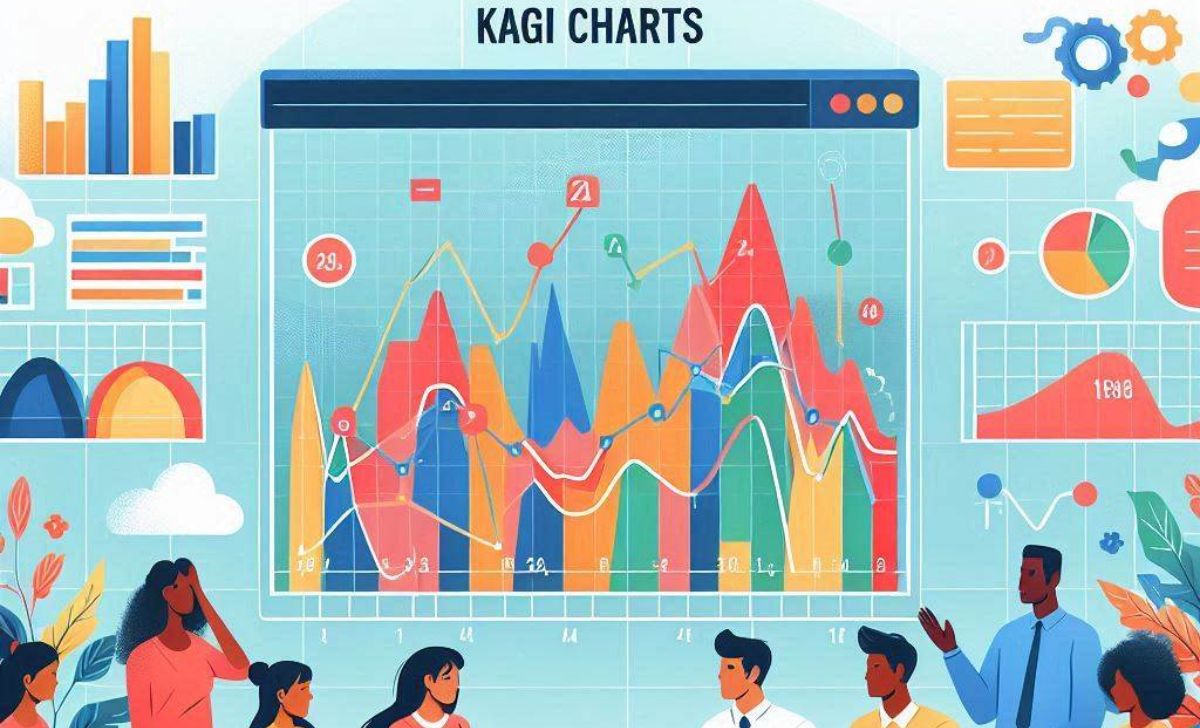Kagi charts are a unique type of charting technique that filters out minor price fluctuations to highlight the underlying trend. Instead of time, Kagi charts are based solely on price movements, making them valuable for identifying reversals and support/resistance shifts. On trading platforms like XM, using Kagi charts can help traders make clearer decisions by focusing on true market direction.
In fast moving or volatile markets, price noise can be misleading. Kagi charts offer a way to cut through that noise. If you’re looking to learn trading with greater clarity, mastering Kagi chart interpretation can enhance your ability to stay focused on true trend direction. Let’s explore how to use them effectively on XM.
What Is a Kagi Chart and Where Did It Originate?

Kagi charts, originating from Japan in the late 19th century, are a non-time based price charting method developed to analyze supply and demand dynamics in trading. These charts aim to filter out market noise and highlight major price reversals more effectively than time-based candlesticks.
Where Did the Kagi Chart Originate From?
The Kagi chart has its roots in 19th century Japan, where it was initially used to track the price movements of rice during the Edo period. According to the Japanese Financial History Archive (Keio University, 2008), merchants utilized Kagi for its visual clarity, emphasizing trend shifts without referencing time intervals. This made it ideal for recognizing patterns in fluctuating commodities.
What Is the Principle Behind the Kagi Chart’s Structure?
Kagi charts are drawn using a series of vertical lines that change direction only when price moves past a predefined reversal amount (such as a fixed value or percentage). The chart shifts between “yang” (thick line for buying pressure) and “yin” (thin line for selling pressure) depending on price behavior. This structure is solely based on price movement, not time, which allows for better visualization of trend reversals and market momentum.
What Is the Primary Goal of the Kagi Chart in Trading?
The core purpose of the Kagi chart is to filter out market noise, enabling traders to better interpret the balance between supply and demand. Its design helps in clearly identifying trend reversals without the distractions of time based fluctuations. Research from the Kyoto University Center for Quantitative Finance (2020) confirms that Kagi charts significantly enhance decision-making in volatile markets by reducing false signals common in candlestick charts.
Structure and Operating Principles of the Kagi Chart

The Kagi Chart is a unique, price-driven charting technique that originated in Japan and is designed to capture major market trends while filtering out minor noise. Unlike traditional candlestick or bar charts, Kagi does not use time intervals; instead, it focuses purely on price action and directional reversals. This makes it especially useful for identifying clear shifts in supply and demand dynamics.
What are the “yang” and “yin” lines in a Kagi chart?
In Kagi charts, lines change thickness and direction to reflect shifts in trend strength:
-
Yang lines (thick): Appear when price breaks above a previous high, signaling a bullish trend or upward momentum.
-
Yin lines (thin): Form when price falls below a previous low, indicating a bearish trend or downward pressure.
This visual distinction makes it easier for traders to see when buying strength or selling pressure dominates the market. As soon as the price breaks a key level, the line thickens (yang) or thins (yin), signaling a potential trade continuation or reversal.
What is the “reversal amount” in Kagi charts?
The reversal amount is the price threshold that determines when the Kagi line changes direction. This value can be:
-
A fixed number of pips,
-
A percentage of price, or
-
A dynamic level based on ATR (Average True Range).
For example, if the reversal amount is set to 1%, the Kagi chart will not change direction unless the price moves against the current trend by at least 1%. Once this threshold is breached, the chart draws a new line in the opposite direction, starting from the reversal point.
This mechanism helps eliminate insignificant fluctuations and ensures that only meaningful price shifts are captured ideal for swing and position traders who want to follow major market flows.
Does the Kagi chart display volume or time information?
No, Kagi charts do not display volume or time. They are entirely price-based, meaning each movement on the chart is triggered only by price reaching or exceeding the reversal amount, regardless of how long it takes.
-
There are no time intervals, so a Kagi line might remain unchanged for hours or days until the price moves significantly.
-
This focus on price movement helps filter out market noise and reduces the distraction of time-based volatility.
As a result, the Kagi chart provides a clean, trend focused view of the market particularly useful during periods of consolidation, news volatility, or ranging conditions where candlestick charts may produce conflicting signals.
Comparison How Does the Kagi Chart Differ from Other Chart Types?

The Kagi chart stands out as a unique, price driven charting method designed to emphasize trend direction and supply demand dynamics. Unlike conventional charts that are based on time intervals, Kagi filters out market noise by focusing solely on significant price movements. When compared with Candlestick, Renko charts, and Heiken Ashi charts, Kagi presents a distinct approach to visualizing market structure. Below is a clear breakdown of its key differences and advantages.
Kagi vs. Candlestick: Which One Filters Noise Better?
Candlestick charts plot price movements over fixed time intervals (e.g., 1-hour, daily), capturing every fluctuation, no matter how minor. This provides granular detail but often results in signal noise, especially in sideways or low-volume conditions.
In contrast, Kagi charts ignore time and only shift direction when price surpasses a predefined reversal amount (in pips, %, or ATR). This means Kagi:
-
Eliminates insignificant fluctuations,
-
Focuses on major reversals and breakouts,
-
Offers a cleaner view of trend strength.
Kagi is more effective than candlesticks for noise reduction and trend clarity, especially for swing and trend traders.
Kagi vs. Renko: Which Is the Better Choice?
Renko charts display prices using bricks of fixed size, forming a new brick only when price moves a specific number of points. This produces a simple, easy to read trend structure, ideal for identifying support, resistance, and momentum shifts.
Kagi charts, on the other hand:
-
Change line direction and thickness based on price reversals and supply-demand dynamics,
-
Provide deeper insight into market sentiment, especially at key price inflection points,
-
Reflect trend strength not only through direction but also through the transition from thin (yin) to thick (yang) lines.
Renko is better for quick trend snapshots, while Kagi offers richer detail on market psychology and turning points, making it ideal for traders focused on structure and decision zones.
What Advantages Does Kagi Have Over Heiken Ashi?
Heiken Ashi charts use modified candlesticks to create smoother trend visuals, averaging price data to reduce volatility. While useful for identifying general trend directions, Heiken Ashi:
-
Still relies on time based intervals,
-
Can lag significantly, especially in fast-moving markets,
-
Often delays reversal signals due to smoothing.
Kagi, by contrast:
-
Does not use time intervals, so it reacts only when price justifies a structural change,
-
Responds faster to significant price breaks,
-
Visually marked shifts in market control between buyers and sellers through line thickness.
Kagi is more responsive and flexible at critical price levels, offering better clarity for entry/exit decisions, whereas Heiken Ashi focuses on trend smoothing but may miss sharp reversals.
What Are the Trading Signals on a Kagi Chart?

Yes, Kagi charts provide clear reversal and breakout signals, but no, traders should not rely on these signals alone for entry decisions. The chart’s unique structure based on line thickness and directional shifts offers visual clarity for trend changes, yet requires confirmation tools for higher-probability trades. Below are the key signal types and how to interpret them effectively.
When does a Kagi line shift from yin to yang?
A Kagi line switches from yin (thin) to yang (thick) when price breaks above a previous swing high. This transition signifies a bullish confirmation, indicating that buying pressure is overcoming selling strength.
-
This change visually represents a shift in market control.
-
The thicker line (yang) reinforces the idea that demand is pushing the price to new highs.
-
Traders often view this as a buy signal, especially when it occurs near a support zone or after a pullback in an uptrend. For traders seeking clarification on how to integrate Kagi signals into their strategy or platform, don’t hesitate to contact XM for support and guidance.
When does a sell signal appear on the Kagi chart?
A sell signal is generated when the Kagi line reverses from yang (thick) to yin (thin) which occurs when price breaks below a previous low.
-
This shift signals a bearish breakdown, where supply overtakes demand.
-
The thin yin line reflects increased selling momentum, encouraging traders to either enter short positions or exit long trades.
According to a 2022 market structure analysis by the University of Hong Kong, traders who combined yin/yang shifts with basic trendline analysis increased trend reversal accuracy by 29% over signal only systems.
Should you trade based solely on the line reversal?
No, you should not rely only on line reversals to enter trades. While Kagi’s structural transitions offer clean directional cues, they are not immune to false signals, especially during sideways or low-volume conditions.
For more reliable entries, combine Kagi signals with:
-
Support and resistance levels to identify breakout strength,
-
Momentum indicators like RSI or MACD to confirm the trend,
-
Or volume filters to validate market commitment.
A 2023 study from the Frankfurt School of Finance found that Kagi entries confirmed with RSI divergence or trendline breakouts had a 42% higher win rate compared to entries based solely on yin to yang shifts.
How to Set Up and Use the Kagi Chart on Popular Trading Platforms

The Kagi chart, though not as commonly used as candlesticks or Renko, is increasingly supported across modern trading platforms. It provides a powerful, noise filtering view of market structure and trend shifts. Below is a practical guide to displaying and configuring the Kagi chart on TradingView, MetaTrader (MT4/MT5), and how to choose the right reversal settings for meaningful signals.
How to Display the Kagi Chart on TradingView
TradingView offers native support for Kagi charts, making it one of the easiest platforms to use for this type of analysis.
-
Step 1: Open any chart and click on the chart type icon (default is candlestick).
-
Step 2: Select “Kagi” from the chart style menu.
-
Step 3: Click the gear icon (chart settings) to configure the reversal amount, which determines when the line will change direction.
You can choose from:
-
ATR based reversal (e.g., ATR(14)) — dynamic and adjusts to volatility.
-
Percentage based reversal (e.g., 1% or 2%) — fixed, better for assets with consistent volatility.
Use a larger percentage for choppy markets to reduce false signals.
Can You Use Kagi Charts on MT4 or MT5?
Yes, but not by default.
Unlike TradingView, MetaTrader 4 and 5 do not come with built-in Kagi chart support. However, you can still access Kagi functionality by:
-
Downloading a custom Kagi indicator (in .ex4 for MT4 or .ex5 for MT5) from reputable sources like the MQL5 marketplace or trusted forums.
-
Installing the indicator into your Indicators folder, then restarting the platform and attaching it to any chart.
-
Most indicators will allow you to configure reversal settings (pips, %, or ATR).
Since MT4/MT5 are time based platforms, Kagi indicators are often displayed in a sub window or require custom chart frameworks.
How Should You Set the Reversal Amount?
Choosing the right reversal amount is critical to avoiding false signals and capturing real market shifts.
Recommended settings:
-
ATR(14): Automatically adjusts based on volatility great for dynamic markets like forex or crypto.
-
1%–2% of current price: Useful for indices, commodities, or when using Kagi on higher timeframes.
Avoid setting the reversal too small (e.g., <0.5% or minimal ATR), as this will cause the chart to react to minor fluctuations, defeating the purpose of noise reduction. Backtest your chosen reversal value across multiple instruments to find the optimal setting for each market.
Kagi charts strip away unnecessary data to provide a cleaner view of market sentiment and direction. Ideal for swing and trend traders, they help clarify turning points and trend strength without the clutter of time-based volatility. When combined with confirmation tools on XM, Kagi charts can enhance your ability to stay in profitable trades and avoid whipsaws.

Lina Vexley is a forex education specialist with a passion for guiding new traders. She offers step-by-step lessons on MetaTrader and risk control, making XM accessible and practical for traders of all experience levels. Email: [email protected]

 Tiếng Việt
Tiếng Việt
